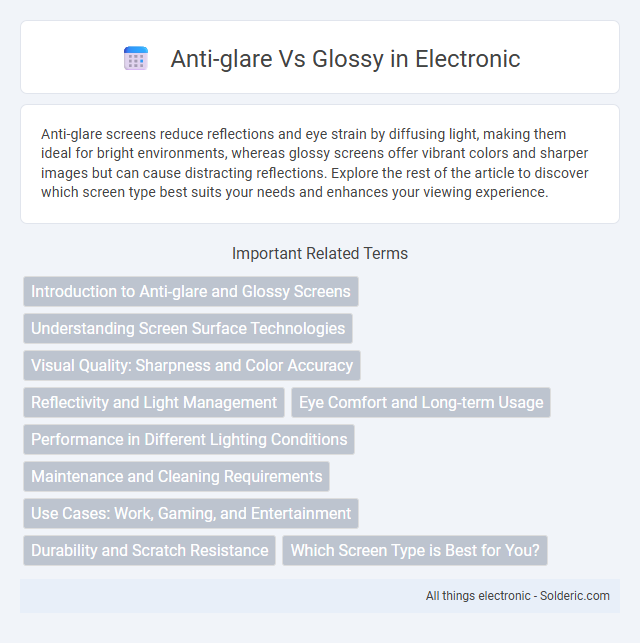Anti-glare screens reduce reflections and eye strain by diffusing light, making them ideal for bright environments, whereas glossy screens offer vibrant colors and sharper images but can cause distracting reflections. Explore the rest of the article to discover which screen type best suits your needs and enhances your viewing experience.
Comparison Table
| Feature | Anti-Glare Screen | Glossy Screen |
|---|---|---|
| Surface Finish | Matte, non-reflective | Shiny, reflective |
| Glare Reduction | High, minimizes reflections | Low, prone to glare |
| Image Vibrancy | Less vibrant, muted colors | More vibrant, rich colors |
| Fingerprint Visibility | Low visibility | High visibility |
| Best Use Case | Bright environments, outdoor use | Indoor use, media consumption |
| Eye Strain | Reduces eye strain in bright light | Can cause eye strain due to reflections |
Introduction to Anti-glare and Glossy Screens
Anti-glare screens use a matte coating to diffuse reflected light, reducing eye strain and improving visibility in bright environments. Glossy screens feature a smooth, reflective surface that enhances color vibrancy and contrast but can cause glare under strong lighting. Choosing between anti-glare and glossy depends on user preferences for image clarity versus reduced reflections.
Understanding Screen Surface Technologies
Anti-glare screen surfaces diffuse ambient light to minimize reflections and reduce eye strain, making them ideal for brightly lit environments and prolonged use. In contrast, glossy screens provide vibrant color reproduction and sharper image contrast by allowing light to pass directly through the panel, enhancing visual clarity in controlled lighting conditions. Choosing between anti-glare and glossy screen technologies depends on balancing glare reduction with color accuracy based on user needs and environmental factors.
Visual Quality: Sharpness and Color Accuracy
Anti-glare screens reduce reflections and diffuse ambient light, enhancing visual comfort without compromising sharpness, ideal for environments with bright lighting. Glossy screens deliver more vibrant colors and higher contrast, offering superior color accuracy and sharper image details, especially in controlled lighting conditions. Your choice depends on whether you prioritize vivid visuals or reduced eye strain in varying light environments.
Reflectivity and Light Management
Anti-glare screens feature a matte coating that diffuses reflected light, reducing glare and minimizing eye strain in brightly lit environments. Glossy screens have a smooth, shiny surface that enhances color saturation and contrast but can produce strong reflections, making them less effective for managing ambient light. Choosing between anti-glare and glossy displays depends on the balance between color vibrancy and the need for controlling light reflections in your specific usage scenario.
Eye Comfort and Long-term Usage
Anti-glare screens reduce reflections and minimize eye strain by diffusing harsh light, making them ideal for prolonged usage and environments with bright lighting. Glossy screens offer vibrant colors and sharp images but can cause more eye fatigue due to glare and reflections over extended periods. For long-term eye comfort, especially during extensive computer work or reading, anti-glare displays are generally the preferred choice.
Performance in Different Lighting Conditions
Anti-glare screens reduce reflections and diffuse ambient light, improving visibility in bright or direct sunlight, making them ideal for outdoor or brightly lit environments. Glossy screens enhance contrast and color vibrancy, performing better in dim or controlled lighting conditions but often struggle with glare and reflections. Choosing between anti-glare and glossy depends on the primary usage environment and lighting conditions for optimal display performance.
Maintenance and Cleaning Requirements
Anti-glare screens require less frequent cleaning since their matte finish resists fingerprints and smudges, reducing visible dirt buildup. Glossy screens demand more regular maintenance as their shiny surface easily shows smudges, dust, and fingerprints, necessitating gentle cleaning with microfiber cloths and screen-safe solutions. Proper cleaning methods for both screen types help maintain clarity and extend their lifespan.
Use Cases: Work, Gaming, and Entertainment
Anti-glare screens reduce reflections and eye strain, making them ideal for work environments with bright lighting or prolonged computer use, while glossy screens enhance color vibrancy and contrast, preferred by gamers and entertainment enthusiasts for immersive visuals. Gamers benefit from glossy displays for sharper image quality and vivid graphics, but anti-glare screens help prevent distractions caused by external light during intense gaming sessions. For entertainment, glossy screens deliver richer colors and deeper blacks for movies and streaming, whereas anti-glare screens provide consistent viewing comfort in various lighting conditions.
Durability and Scratch Resistance
Anti-glare screens typically offer superior durability and scratch resistance compared to glossy displays due to their matte coatings that absorb and diffuse light, reducing visible damage from everyday use. Glossy screens, while often delivering more vibrant colors and sharper images, tend to be more susceptible to scratches and fingerprint marks because of their smooth, reflective surfaces. Considering your device's longevity, an anti-glare screen can better protect against wear and tear, preserving visual clarity over time.
Which Screen Type is Best for You?
Choosing between anti-glare and glossy screens depends on your usage environment and preferences. Anti-glare screens reduce reflections and eye strain, making them ideal for brightly lit or outdoor settings, while glossy screens offer vibrant colors and sharper images, suited for gaming and multimedia consumption. Your decision should balance glare control with image quality based on where and how you use your device most often.
Anti-glare vs Glossy Infographic

 solderic.com
solderic.com